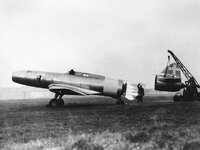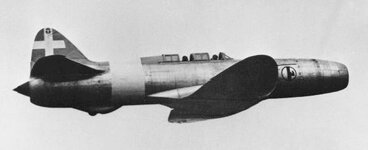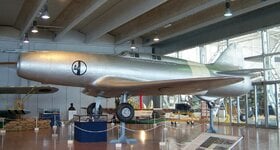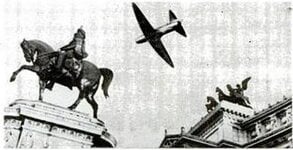My 2¢ Perhaps it should count if the jet engine was intended to provide all or part of the power so that the aircraft could fly, but not if the jet was merely carried aloft by the aircraft so that the jet could be tested. The "not intended for production" clause might rule out quite a few of them, and I don't think that is what we want here.There are two P-51Ds that would *technically* qualify, though they were only test beds.
One of the tests, had a P-51D fitted with two XRJ-30 ramjets (one in each wingtip).
The other P-51D was fitted with two PJ31-1 Pulsejet engines, one under each wing.
This is just for fun, by the way - they shouldn't be on the list because they were just test aircraft and not intended for production.
Navigation
Install the app
How to install the app on iOS
Follow along with the video below to see how to install our site as a web app on your home screen.
Note: This feature may not be available in some browsers.
More options
You are using an out of date browser. It may not display this or other websites correctly.
You should upgrade or use an alternative browser.
You should upgrade or use an alternative browser.
Jet Aircraft that Flew in the 1940s
- Thread starter GregP
- Start date
Ad: This forum contains affiliate links to products on Amazon and eBay. More information in Terms and rules
More options
Who Replied?GrauGeist
Generalfeldmarschall zur Luftschiff Abteilung
The ramjet and pulsejet P-51s weren't testing the engines, they were testing the feasibility of a mixed power upgrade for fighters that were currently in production and/or available in large numbers.My 2¢ Perhaps it should count if the jet engine was intended to provide all or part of the power so that the aircraft could fly, but not if the jet was merely carried aloft by the aircraft so that the jet could be tested. The "not intended for production" clause might rule out quite a few of them, and I don't think that is what we want here.
They were legitimate mixed power, just proof of concept - and a fun bit of early jet history.
The small ramjet was a popular subject of experimentation on a wide range of aircraft from the mid-40's through the 50's, being tested on everything, including helicopters (on the rotors tips, no less).
wuzak
Captain
If the P-51 with ramjets is in, what about the Do 17Z with ramjet?
Or teh Do 217E with ramjet?
Or teh Do 217E with ramjet?
GrauGeist
Generalfeldmarschall zur Luftschiff Abteilung
It would have been a mighty brave pilot to fly such a scary contraption...If the P-51 with ramjets is in, what about the Do 17Z with ramjet?
Or teh Do 217E with ramjet?
The pulsejet powered Me328 (or above mentioned P-51) would have been bad enough!
The ramjet and pulsejet P-51s weren't testing the engines, they were testing the feasibility of a mixed power upgrade for fighters that were currently in production and/or available in large numbers.
They were legitimate mixed power, just proof of concept - and a fun bit of early jet history.
The small ramjet was a popular subject of experimentation on a wide range of aircraft from the mid-40's through the 50's, being tested on everything, including helicopters (on the rotors tips, no less).
Fair enough.
LaughingDragon
Recruit
- 1
- Mar 16, 2022
Greg what about the Caproni Campini N.1, I didn't see it on your list . But then again I am new with a Ginormous brain for aviation.
Attachments
-
 Campini -Caproni .2 during a ground test, with the tail section removed. Note the lit burner w...jpg91.8 KB · Views: 49
Campini -Caproni .2 during a ground test, with the tail section removed. Note the lit burner w...jpg91.8 KB · Views: 49 -
 Campini-Caproni CC-2 aircraft.jpg14.7 KB · Views: 50
Campini-Caproni CC-2 aircraft.jpg14.7 KB · Views: 50 -
 The surviving C.C.2 at the Italian Air Force Museum.jpg341.1 KB · Views: 53
The surviving C.C.2 at the Italian Air Force Museum.jpg341.1 KB · Views: 53 -
 Campini CC2 overflying Piazza Venezia,Rome 1941.jpg27.1 KB · Views: 53
Campini CC2 overflying Piazza Venezia,Rome 1941.jpg27.1 KB · Views: 53
- Thread starter
- #67
GregP
Major
The compressor used a piston engine, but the result was a jet, albeit a SLOW one. Nobody ever said a jet has to be fast.
Let's add it.
Hi Wayne, I suppose if it had a jet engine on it, turbojet (centrifugal or axial), ramjet, or piston-compressor jet, and flew in the 1940s, it's fair game. Let's add them, too.
Might as well include manned rocket planes like the manned V-1. After all, they all are flying without a propeller driven by a piston engine.
Let's add it.
Hi Wayne, I suppose if it had a jet engine on it, turbojet (centrifugal or axial), ramjet, or piston-compressor jet, and flew in the 1940s, it's fair game. Let's add them, too.
Might as well include manned rocket planes like the manned V-1. After all, they all are flying without a propeller driven by a piston engine.
GrauGeist
Generalfeldmarschall zur Luftschiff Abteilung
The Fi103r would fall under a jet aircraft, since the As014 engine was a pulse-jet.The compressor used a piston engine, but the result was a jet, albeit a SLOW one. Nobody ever said a jet has to be fast.
Let's add it.
Hi Wayne, I suppose if it had a jet engine on it, turbojet (centrifugal or axial), ramjet, or piston-compressor jet, and flew in the 1940s, it's fair game. Let's add them, too.
Might as well include manned rocket planes like the manned V-1. After all, they all are flying without a propeller driven by a piston engine.
The Me163 and MXY-7 really don't qualify.
Last edited:
- Thread starter
- #69
GregP
Major
Since I restored a pulsejet to operation, you'd THINK I should KNOW that. Slip of the tongue ...
Here's a clip of the pulsejet we restored and got running:
That's my Nissan Titan we're pushing down the runway.
Here's another run. We scared the bejezus out of the poor girl in the C-150. I'm sitting in the truck on the right as you see the clip:
Pin on Projects to try
Here's a clip of the pulsejet we restored and got running:
That's my Nissan Titan we're pushing down the runway.
Here's another run. We scared the bejezus out of the poor girl in the C-150. I'm sitting in the truck on the right as you see the clip:
Pin on Projects to try
GrauGeist
Generalfeldmarschall zur Luftschiff Abteilung
Greg, don't recall if I asked before, but is that an original Argus or the Ford PJ-31 clone?
- Thread starter
- #71
GregP
Major
It is a U.S. clone, likely by Marquardt Aviation or Ford. We saw a few things that led us to believe Marquardt.
Yanks Air Museum has a genuine Argus V-1 and I'd love to get it running, but the only reason we got THIS one running was Robin Scott's skill and determination to make a working rubber diaphragm for the fuel controller. It took him 6 - 8 tries, but he got one to work. I don't have his workshop (he passed away several years back) or his knowledge of forming rubber. However, if we COULD get a diaphragm, I'm sure we could get the Argus running. That assumes the reed valves are still good ... I haven't looked at them as yet.
The main reason it doesn't LOOK like a German pulsetjet above is the fact that we made the cowling from scratch and the shape isn't exactly what were were shooting for, but it certainly worked. After we added the cowling, the thrust went up by some 75% Seems ludicrous, but giving the inlet a streamlined inlet duct REALLY woke up the pulsejet. Without the cowling, we were getting about 120 pounds of thrust. With the cowling, it went up to 210 pounds! That doesn't exactly snap your head back when pushing a Nissan Titan and trailer combination that weighted 10,000 pounds total, but after Bob gave it a small bit a gas and shifted to neutral, it got us up to about 35 mph before we ran out of fuel (2.5 U.S. gallons of 87-Octane unleaded gasoline).
The front piece was done by metal spinning and we polished it for maybe 10 hours to get the shiny finish on it. Took maybe 2 hours to make the metal spinning form block.
Yanks Air Museum has a genuine Argus V-1 and I'd love to get it running, but the only reason we got THIS one running was Robin Scott's skill and determination to make a working rubber diaphragm for the fuel controller. It took him 6 - 8 tries, but he got one to work. I don't have his workshop (he passed away several years back) or his knowledge of forming rubber. However, if we COULD get a diaphragm, I'm sure we could get the Argus running. That assumes the reed valves are still good ... I haven't looked at them as yet.
The main reason it doesn't LOOK like a German pulsetjet above is the fact that we made the cowling from scratch and the shape isn't exactly what were were shooting for, but it certainly worked. After we added the cowling, the thrust went up by some 75% Seems ludicrous, but giving the inlet a streamlined inlet duct REALLY woke up the pulsejet. Without the cowling, we were getting about 120 pounds of thrust. With the cowling, it went up to 210 pounds! That doesn't exactly snap your head back when pushing a Nissan Titan and trailer combination that weighted 10,000 pounds total, but after Bob gave it a small bit a gas and shifted to neutral, it got us up to about 35 mph before we ran out of fuel (2.5 U.S. gallons of 87-Octane unleaded gasoline).
The front piece was done by metal spinning and we polished it for maybe 10 hours to get the shiny finish on it. Took maybe 2 hours to make the metal spinning form block.
Last edited:
Snautzer01
Marshal
- 46,292
- Mar 26, 2007
Would a drawing of a diaphragm help? I might have one. And otherwise take out working diaphragm 3d precise scan then print might be an option.
- Thread starter
- #73
GregP
Major
Hi Snautzer01. Why yes, it might. The mold that Robin eventually made that worked would NOT fit the Argus pulsejet, but having a drawing of the correct diaphragm might eventually make running the Argus possible.
Wow. Thanks!
Wow. Thanks!
pinehilljoe
Staff Sergeant
- 881
- May 1, 2016
In post #43 above, the Mirage 4000 is mentioned, but the picture is of a single-engine Mirage.
Mirage 4000 below:
View attachment 660733
Decidedly twin-engine. Unfortunately, nobody bought it, so it remained a company demonstrator. Another company also made a company-funded fighter, the Northrop F-20, which ALSO never sold and remained a company airplane. The moral of the story would be:
Never developed a cutting-edge jet fighter without a firm order from a customer that makes the development profitable. If the customer is not your own country, you also had better make sure the sale is approved for foreign purchase before spending said money on development. If you develop an airplane without orders, the odds are not in your company's favor to sell it.
- On the cancellation in 1965 of the BAC TSR-2: All modern aircraft have four dimensions: span, length, height and politics. TSR-2 got just the first three right... Sydney Camm
Good list, but no mention of the Gloster E.28/39 in 1941, Britain's first jet. Also the Supermarine Attacker prototype in 1946, which led to....
Just to clarify, the Supermarine 510 did lead to the Swift and I have seen it referred to as the Swift prototype, but the two aircraft were very different. It had more in common with the Attacker than the Swift. It was a testbed and was not truly representative of the latter. The follow-on Supermarine Type 528 was more representative of the Swift in size and aerodynamics and having a tricycle gear, but it first flew in 1950 so just misses out on this list.
The 510 survives, it belongs to the RAF Museum but is on loan to the FAA Museum.
 DSC_0023
DSC_0023
Here's a Swift, for kicks.
 NAM 73
NAM 73
89. The Supermarine 510/517 flew in 1948, and became the Swift.
Just to clarify, the Supermarine 510 did lead to the Swift and I have seen it referred to as the Swift prototype, but the two aircraft were very different. It had more in common with the Attacker than the Swift. It was a testbed and was not truly representative of the latter. The follow-on Supermarine Type 528 was more representative of the Swift in size and aerodynamics and having a tricycle gear, but it first flew in 1950 so just misses out on this list.
The 510 survives, it belongs to the RAF Museum but is on loan to the FAA Museum.
Here's a Swift, for kicks.
When I search "Supermarine 510 wikipedia" I get taken to the article about the Supermarine Swift, and there is a mention of the 510 being one of the early prototypes of the Swift. I suppose it's a matter of point of view, and one's interpretation of words like "prototype" and "led to" and "became."
Would it be safe just to say the the 510 was part of the Swift's "family tree"?
Would it be safe just to say the the 510 was part of the Swift's "family tree"?
Admiral Beez
Major
I wonder what Mitchell would have made for Supermarine had he survived into the 1960s. I expect Supermarine's first jet won't be an Attacker with a Spiteful's wings tacked on.
When I search "Supermarine 510 wikipedia" I get taken to the article about the Supermarine Swift, and there is a mention of the 510 being one of the early prototypes of the Swift.
Well, that settles it, then...
The 510 came about from specification E.41/46, which was designed to investigate swept wing characteristics leading to the development of the Swift, so VV106 was a testbed based on the Attacker that "investigated sweepback and its associated control and stability problems", as the wording of the original specification reads.
VV119, the 528 was the second aircraft built to E.41/46, but it was modified and became the Type 535 and was completely different in every way to its sibling, having new wings, new fuselage, new tail surfaces, new undercarriage layout and was more representative of what the Swift became. Here's an aerodynamic model.
You're probably right, it's just semantics on my part, but VV106 and VV119 were very different aircraft, despite being from the same specification.
- Thread starter
- #79
GregP
Major
Here's my drawing of the Jet Fury that was the P-1035, which turned into the P-1040 (two exhausts, became the Sea Hawk), to the P-1052 (swept wing) and, finally, the P-1081 (swept wing and tail) before becoming the prototype Hunter with a longer nose and fuselage.

The wings and tail are pure Fury / Sea Fury in the P-1035, and the fuselage is whatever took the turbojet with the cockpit up front. After damaging runways and carrier decks, they also went away from conventional landing gear for a production aircraft. No national markings because it never went past the paper airplane stage.
The wings and tail are pure Fury / Sea Fury in the P-1035, and the fuselage is whatever took the turbojet with the cockpit up front. After damaging runways and carrier decks, they also went away from conventional landing gear for a production aircraft. No national markings because it never went past the paper airplane stage.
Users who are viewing this thread
Total: 1 (members: 0, guests: 1)
